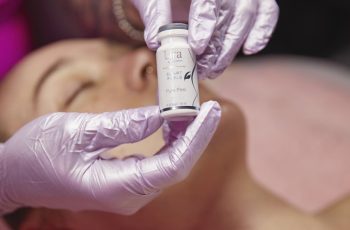Can BHAs be mixed with Vitamin C?
Whether you love exfoliating or not, there’s no denying that you’ll notice a noticeable change in your complexion. Luckily, we no longer have to rely on physical exfoliants to remove unwanted debris from the surface of our skin.
Chemical peels are nothing new, but their popularity has skyrocketed in recent years, with many of us using exfoliating toners in our skincare routines.
With all these acids, the question remains: are there some that should be avoided, while others are more effective in combination? The two main ingredients we’re going to focus on are Vitamin C and Beta Hydroxy Acids, aka
BHAs. So if you want to learn more about how these powerhouses work on your skin, what benefits they have, and whether you can combine BHAs with Vitamin C, stay tuned.
What are the benefits of BHAs?
Short for beta hydroxy acids, BHAs are a class of chemical exfoliants that penetrate deeper into the skin than their close cousins, alpha hydroxy acids (AHAs). They’re oil-soluble, which makes them very effective against problematic and acne-prone skin. They do this by removing excess sebum from the skin and removing bacteria, dirt, and other impurities from the pores. Over time, these issues can become more severe and develop into blemishes such as blackheads, redness, and a dull complexion. Due to their high potency, it is best to avoid mixing with other acids. This is because the risk of irritation increases, with the skin becoming itchy, blotchy, or red, and sometimes a rash. The most commonly used BHA in many skincare products is salicylic acid. Derived from willow bark, this acid has a smaller molecular size, which means it can penetrate into the lower layers of the skin, preventing further breakouts and reducing inflammation. Here are the main benefits of salicylic acid:
Helps clear pore-clogging bacteria, dirt, and debris that can build up in the pores and cause blackheads and other skin imperfections.
Helps reduce and regulate the skin’s sebum production. This is especially effective for people with oily and acne-prone skin.
It removes dead skin cells from the surface of the skin that cause acne and a dull complexion.
It has anti-inflammatory properties, which means it can help counteract any redness or inflammation on the skin.
If you want to learn more about salicylic acid and other BHAs, read our dedicated blog post.
What are the benefits of Vitamin C?
Vitamin C, also known as ascorbic acid and L-ascorbic acid, is a powerful antioxidant and an effective ingredient in skincare that can help with a variety of issues.
Supports the lipid barrier, ensuring it is strong enough to protect the skin from free radicals such as pollution, UV rays, central heating and other oxidative stressors.
Helps to brighten the skin and minimise the appearance of hyperpigmentation. This works by inhibiting the enzyme that produces melanin, which causes skin pigmentation.
Contains anti-inflammatory properties, which means Vitamin C can fight redness on the skin.
Increases collagen production, tightens the skin, maintains elasticity and gives it a youthful tone.
Do you want to know more about Vitamin C? Read our special blog post on beauty insiders.
Now that we’ve briefly discussed the benefits of BHAs and Vitamin C, let’s take a deeper look and learn how to use them together effectively.
Can BHAs and Vitamin C be used together?
Yes, you can, but only in certain ways to prevent skin irritation. Here are some examples of how to best use them together.
Option One – Use Them at Different Times of the Day
Since both acids have an acidic pH, using them together can cause an imbalance in skin pH and cause irritation. To avoid this, it’s best to leave plenty of time between applications. Many people find that Vitamin C works best for radiance and antioxidant protection during their morning routine. Use the BHA at night as well so it can penetrate the skin without being polluted by free radicals.
Option Two – Use Them on Different Nights
If you find that the first option causes skin irritation, you can take the Vitamin C and BHA separately at night. This ensures that each ingredient can do its job without fighting against daily skin aggressors. While Vitamin C ointment is usually best used during the day, you’ll find that its antioxidant properties make it just as effective at night to repair existing damage and prevent further skin damage.
There are two popular options here, but there’s another option that’s best for those who can tolerate both ingredients. You can add Vitamin C to your BHA. All you need to do is leave about 20 minutes between applications to allow your skin to calm down and prepare for the next step in your routine.
Which came first, Vitamin C or BHA?
If your skin can tolerate using both ingredients in the same routine, it’s best to start with a BHA product. This is because it’s an oil-soluble product, so it can penetrate deeper into the skin. It also removes built-up dead skin cells and dirt, and removes the skin barrier, allowing Vitamin C and other active ingredients to absorb quickly and show results faster.
If you have any questions about using any of these ingredients, you should consult your doctor or a trained professional. I also recommend doing a 24-hour patch test to see if these active ingredients are right for you and your skin’s needs.
I hope this article answered any questions you may have about the BHA and Vitamin C combination. Don’t forget to connect with one of our skincare experts on Instagram.
DQH Knowledge drop: In your 20s, your skin cell turnover decreases. (Cell turnover is a key component in keeping your skin youthful.) You know what else slows down? Your collagen production. Starting in your 20s, collagen decreases by about 1 percent per year. Should you want to prevent fine lines and wrinkles, start by eliminating behaviors that contribute to premature aging. “If it’s bad for you, it’s bad for your skin,” says dermatologist Michel Somenek.
“Cigarette smoking reduces blood flow to the skin and causes premature wrinkling and a dull skin texture. Making the repeated pursed motion to inhale can also cause smoker’s lines. Alcohol and recreational drugs are toxins for the skin that damage its cellular structure and DNA,” Somenek tells us. “The faster you eliminate vices while you are young, the better chance your skin and body have to recuperate.” Also, adopting an anti-aging routine in your 20s is key. After all, the best offense is a good defense. We spoke to Somenek and experts Joshua Ross and Audrey Kunin to find out more.
Keep reading for the best anti-aging products for your 20s, according to skincare professionals.
Sunscreen
“We all know that the sun is the number one cause of skin aging and starting the prevention in your 20s is very important,” Ross says. “The majority of your sun damage won’t start to appear until you’re in your 30s, so don’t wait until you see it surface or you’ll be behind the curve. Stay ahead of it with a good-quality zinc-based sunscreen worn daily.”
Farmacy Green Defense Daily Mineral Sunscreen
An invisible sunscreen with SPF 30, plus botanical extracts meant to protect skin with tons of antioxidants. Bonus: It’s clean and fine to use under makeup.
Bareminerals Complexion Rescue™ Tinted Moisturizer Broad Spectrum SPF 30
Although we recommend you use your SPF and moisturizer separately, we also understand moments when you don’t have time or energy for that extra step. For those times, this bareMinerals moisturizer is a great thing to have on hand.
Vitamin C Serum
“A great introduction to anti-aging is to start with a vitamin C serum in your morning skincare routine,” Ross says. “It’s a powerful antioxidant that will neutralize free radicals and brighten the skin.” He adds that it’s a great way to counteract the effects of the sun’s harmful rays, which, as previously mentioned, are among the biggest causes of premature aging.
Drunk Elephant C-Firma™ Vitamin C Day Serum
The Drunk Elephant C-Firma is a lightweight serum that promises to give skin a glow by combining the brightening powers of vitamin C with ferulic acid, l-ascorbic acid, and vitamin E. The included sodium hyaluronate is meant to replace hydration loss, so you shouldn’t have to deal with any irritation.
Sunday Riley C.E.O. Rapid Flash Brightening Serum
This potent serum is jam-packed with vitamin C (15 percent, to be exact), which means it’s a potential superstar at both brightening skin and dousing it in antioxidants.
Peptides
Using peptides on your skin has many benefits, says Somenek. “The skin barrier is what defends the body against pollution, UV rays, bacteria, and toxins. It can be damaged by several everyday factors. Using topical peptides aids in building a stronger barrier,” he says. “Peptides comprise elastic fibers, which are a type of protein. These fibers help to make skin appear taut and firm. Peptides can also help repair damaged skin, relieve inflammation, and even out skin tone. Some peptides can kill acne-causing bacteria that is common in 20-somethings.”
Kunin agrees, saying, “Peptides are an excellent entry point for supporting collagen.” She recommends looking for face and eye treatments that contain these collagen-boosting powerhouses.
Charlotte Tilbury Magic Eye Rescue Cream
This Charlotte Tilbury super-emollient eye cream has a base of coconut oil and shea butter (read: it’s incredibly hydrating). Botanicals plus peptides are meant to help reduce dark circles and boost collagen, respectively.
This creamy moisturizer serves up potent collagen-boosting peptides and pycnogenol, and antioxidant-rich vitamin C. “Instead of sitting on top of the skin, peptides penetrate the outer layer so they go deep. The ‘signals’ they send tell the cells to produce elastin and collagen, which are needed for youthful-looking skin,” explains Somenek.
At-Home Peel Pads
Remember that skin cell turnover fiasco we talked about earlier? One way to help support it is by exfoliating. “Exfoliation is important to help keep skin fresh and luminous,” Kunin says. She recommends using at-home peel pads as an easy and effective way to exfoliate.
“The goal in your 20s is to fight the slowing pace of cell turnover. It is wise to use products that gently exfoliate, yet still remove oil and other impurities. Products that have Alpha Hydroxy Acids (AHA) or Beta Hydroxy Acids (BHA) are a good choice.”
According to Somenek, you should only exfoliate two to three times a week. “People of all ages are guilty of over-exfoliating and that can be too much of a good thing,” he says.
Dermadoctor Kakadu C Intensive Vitamin C Peel Pad
A few swipes of this Derma Doctor powerful peel pad promise to leave your skin glowing and smooth, thanks to the seven (yes, seven) types of chemical exfoliants, including AHA and BHA. It also contains vitamin C via Kakadu plum extract for added brightening and antioxidant protection.
KEY INGREDIENTS Kakadu plum extract is sourced from the Kakadu plum, a fruit grown in northern Australia. It contains vitamin C, which restores the skin’s natural barrier, increases collagen production, and soothes irritation.
Dr. Dennis Gross Skincare Alpha Beta® Universal Daily Peel Pads
These are the gold standard of peel pads, with a cult following and over 900 five-star reviews on Sephora. They’re easy to use and contain a blend of anti-aging exfoliating acids.
Emollient Night Cream
“In your 20s, you need to start upping the hydration in your skincare routine. You may have been cautious of over-moisturizing because of acne in your teens, but as you enter your 20s, your skin transitions and becomes drier,” Ross says. “I recommend an emollient night cream added into your evening skincare regimen.”
“Twenty-somethings need to make sure that they are not using creams that will clog their pores and cause excess oil production,” says Somenek. Opt for non-comedogenic products.
Cerave Skin Renewing Night Cream
One great choice is the CeraVe Skin Renewing Night Cream, which is a non-comedogenic night cream that leaves skin soft and glowy. It combines the moisturizing powers of ceramides and hyaluronic acid.
RoC Retinol Correxion Max Hydration Creme
“The best night cream ingredients contain retinol, benzoyl peroxide, and/or salicylic acid or hyaluronic acid. The goal is to moisturize, yet remove excess oil,” says Somenek. This Roc Retinol Correxion cream fits the bill as it contains both hyaluronic acid and retinol so it promises to moisturize while also being non-comedogenic.



